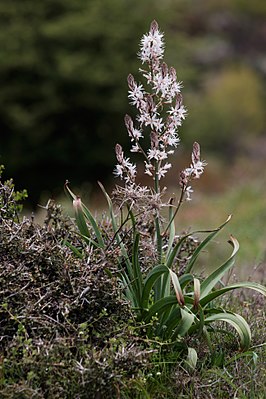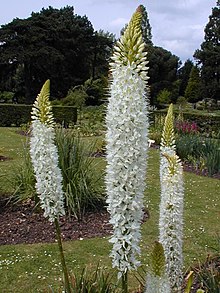Affodill family
| Affodill family | ||||||||||||
|---|---|---|---|---|---|---|---|---|---|---|---|---|

Asphodelus aestivus |
||||||||||||
| Systematics | ||||||||||||
|
||||||||||||
| Scientific name | ||||||||||||
| Asphodeloideae | ||||||||||||
| Burnett |

The Affodillgewächse (Asphodeloideae) are a subfamily of the grass tree family (Xanthorrhoeaceae) in the order of the Asparagales (Asparagales) within the monocotyledons . They were previously assigned to the lily family (Liliaceae). Some species are medicinal plants - such as aloe vera . Many species and their varieties are used as ornamental plants in parks, gardens and spaces.
description
Vegetative characteristics
They are usually perennial, herbaceous plants that often develop rhizomes as persistent organs. Some taxa are succulents , rarely tree-shaped plants.
The leaves are alternate and predominantly arranged in a spiral in leaf rosettes; mostly rosettes are basal but in tree-like species terminal and tuft-like. The simple and parallel- veined leaves are herbaceous or leathery.
Generative characteristics
The flowers are usually in the axilla of bracts in terminal clusters or ears . The flowers are like most monocots trifoliate, there are thus six bloom present. They are shaped the same or different and free or grown together. There are two circles with free, fertile stamens . The three pistils have become a top permanent ovary grown.
The flower formula is:
There are fruit capsules formed.
ingredients
Anthracene derivatives ( anthranoids , anthraglycosides ) are mostly contained in so-called aloin cells - anthranoid -containing parenchymatic cells - which surround the phloem side of the leaf vascular bundle ; Steroid saponins are almost absent.
Systematics and distribution
The subfamily of the Affodilla family contains around 15 genera and around 800 species. The distribution is ancient , with emphasis in Africa and especially in the Capensis ; Another focus extends from the Mediterranean region to Central Asia. The genus Bulbinella is native to New Zealand as a specialty of distribution .
The molecular genetic investigations in the last ten years have led to the fact that the family boundaries within the order of the Asparagales have shifted significantly. The systematics of these genera, subfamilies, families has been discussed for a long time, so one will often encounter apparent inconsistencies in the literature. The systematics according to Mark W. Chase u. a. 2009. The family of the grass tree plants (Xanthorrhoeaceae Dum. ) Was expanded to include the taxa of the former families Affodilaceae (Asphodelaceae) and daylily plants (Hemerocallidaceae). The former Asphodelaceae Juss family. is downgraded to the rank of a subfamily Asphodeloideae Burnett .

Asphodelaceae was first published in 1789 by Antoine Laurent de Jussieu in Genera Plantarum. P. 51 under the name "Asphodeli". Asphodeloideae was founded in 1835 by Gilbert Thomas Burnett in Outlines of Botany. P. 427 published. The type genus is Asphodelus L.
Based on more recent phylogenetic studies, Olwen Megan Grace and co-workers suggested various taxonomic changes in early 2013. The species of the genus Chortolirion are included in the genus Aloe , Aloe plicatilis is included in the monotypic genus Kumara Medik. (1786) referred back. In the new genus Aloidendron (A.Berger) Klopper & Gideon F.Sm. six tree-shaped aloes and the new genus Aloiampelos Klopper & Gideon F.Sm. seven mainly climbing aloes spun off.
The subfamily Asphodeloideae contains about 15 genera:
- Aloidendron (A.Berger) Klopper & Gideon F.Sm. : It contains about six species that belonged to the genus Aloe before 2013. The distribution area is mainly southern Africa, only one species occurs in Somalia .
- Aloiampelos Klopper & Gideon F.Sm. : It contains about seven species that belonged to the genus Aloe before 2013. All seven species are floral elements of the Capensis and occur only in the South African provinces of the Western Cape and Eastern Cape ; only one species extends to Swaziland .
- Aloes ( Aloe L. , including Lomatophyllum Willd. And Chortolirion A.Berger ): The approximately 500 species are mainly found in southern Africa as well as in East Africa and offshore islands such as Madagascar and the Mascarene Islands and in the southwest of the Arabian Peninsula .
- Junkerlilien ( Asphodeline Rchb. ): The approximately 17 species occur mainly in the Mediterranean area.
- Affodill ( Asphodelus L. ): The approximately 16 species occur from the Mediterranean to India and in the deserts bordering to the south.
- Astroloba Uitewaal : The six or so species are floral elements of the Capensis and occur only in the South African provinces of the Western Cape and Eastern Cape.
- Bulbine Wolf : The 50 to 60 species occur mainly in tropical and southern Africa; some species in Australia.
- Bulbinella Kunth : Of the approximately 23 species, 14 are native to the Capensis , while most of the others arenativeto New Zealand .
- Steppe candles ( Eremurus M.Bieb. ): The approximately 40 to 45 species occur in central and western Asia, often in mountainous areas.
- Gasteria Duval : The approximately 22 species occur in the Capensis.
- Haworthia Duval : The approximately 144 species are distributed in southern Africa.
- Jodrellia Baijnath : The only three species are distributed from Central to Northeast Africa.
- Torch lilies ( Kniphofia Moench ): The approximately 65 to 70 species occur mainly in tropical and southern Africa; one species on the Arabian Peninsula and one species on Madagascar.
-
Kumara med. : It contains only two species from the Capensis:
- Kumara haemanthifolia (Marloth & A.Berger) Boatwr. & JCManning
- Kumara plicatilis (L.) GDRowley (Syn .: Aloe plicatilis (L.) Burm.f. ): This endemic occurs only in the South African province of Western Cape.
-
Poellnitzia Uitewaal : It contains only one species:
- Poellnitzia rubriflora (L.Bolus) Uitewaal : This endemic occurs only in the South African province of Western Cape . Some authors also call it Astroloba rubriflora (L.Bolus) Gideon F.Sm. & JCManning to the genus Astroloba .
- Trachyandra Kunth : The approximately 50 to 65 species occur in tropical and southern Africa and on Madagascar.
Generic hybrid (intergeneric hybrids) are:
- × Algastoloba D.M.Cumming (= Aloe × Astroloba × Gasteria )
- × Alolirion G.D.Rowley (= Aloe × Chortolirion )
- × Aloloba G.D.Rowley (= Aloe × Astroloba )
- × Alworthia G.D.Rowley (= Aloe × Haworthia )
- × Astroworthia G.D. Rowley (= Astroloba × Haworthia )
- × Bayerara D.M.Cumming (= Aloe × Gasteria × Haworthia )
- × Cummingara G.D.Rowley (= Gasteria × Haworthia × Poellnitzia )
- × Gasteraloe Guillaumin (= Aloe × Gasteria )
- × Gasterhaworthia Guillaumin (= Gasteria × Haworthia )
- × Gastroloba D.M. Cumming (= Astroloba × Gasteria )
- × Maysara D.M. Cumming (= Astroloba × Gasteria × Haworthia )
- × Poellneria G.D.Rowley (= Gasteria × Poellnitzia )
swell
Internet
- The subfamily of the Asphodeloideae on the AP website. (Section System and Description) viewed in April 2010.
- University of Greifswald, Pharmacy - Asphodelaceae.
Individual evidence
- ↑ Angiosperm Phylogeny Group: An update of the Angiosperm Phylogeny Group classification for the orders and families of flowering plants: APG III. In: Botanical Journal of the Linnean Society. Volume 161, No. 2, 2009, pp. 105-121, doi: 10.1111 / j.1095-8339.2009.00996.x .
- ↑ Mark W. Chase, James L. Reveal, Michael F. Fay: A subfamilial classification for the expanded asparagalean families Amaryllidaceae, Asparagaceae and Xanthorrhoeaceae. In: Botanical Journal of the Linnean Society. Volume 161, number 2, 2009, pp. 132-136, doi: 10.1111 / j.1095-8339.2009.00999.x .
- ^ Antoine Laurent de Jussieu: Genera Plantarum. 1789, p. 51 ( digitized version ).
- ↑ Asphodeloideae in the Germplasm Resources Information Network (GRIN), USDA , ARS , National Genetic Resources Program. National Germplasm Resources Laboratory, Beltsville, Maryland.
- ↑ a b Olwen Megan Grace, Ronell R. Klopper, Gideon F. Smith, Neil R. Crouch, Estrela Figueiredo, Nina Ronsted, Abraham E. van Wyk: A revised generic classification for Aloe (Xanthorrhoeaceae subfam. Asphodeloideae). In: Phytotaxa. Volume 76, No. 1, 2013, pp. 7-14 doi: 10.11646 / phytotaxa.76.1.1 .
- ^ Gideon F. Smith, Ben-Erik Van Wyk: Asphodelaceae. In: Klaus Kubitzki (Ed.): The Families and Genera of Vascular Plants . Volume 3: Flowering Plants. Monocotyledons. Lilianae (except Orchidaceae) . Springer, Berlin / Heidelberg / New York 1998, ISBN 3-540-64060-6 , pp. 136 (English, limited preview in Google Book Search).
- ^ A b Rafaël Govaerts (ed.): Asphodelaceae - World Checklist of Selected Plant Families of the Royal Botanic Gardens, Kew. Last accessed on July 26, 2018.
- ^ Ronell R. Klopper, Gideon F. Smith, Abraham E. van Wyk: The correct name of Aloe plicatilis, the fan aloe, in the genus Kumara (Asphodelaceae: Alooideae), again. In: Bradleya. Volume 31, 2013, pp. 157–158, ( PDF file ).
further reading
- DS Devey, I. Leitch, PJ Rudall, JC Pires, Y. Pillon, MW Chase: Systematics of Xanthorrhoeaceae sensu lato, with an emphasis on Bulbine. In: Aliso. Volume 22, 2006, pp. 345-351.
- Ronell R. Klopper, Abraham E. van Wyk, Gideon F. Smith: Phylogenetic relationships in the family Asphodelaceae (Asparagales). In: Schumannia. Volume 6, 2010, pp. 9-36 ( PDF file ).
Web links
- Description of the Asphodelaceae family at DELTA by L. Watson & MJ Dallwitz. (with a different generic scope, English)




